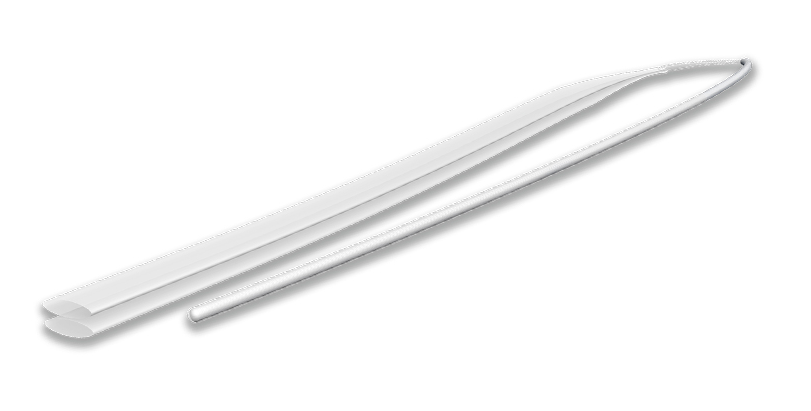
Benefits
- Retrieve retracted tendon end with minimal incision.
- Reduce the risk of damage to tendon end compared to standard technique*
- Potential to avoid repeat suturing of the tendon end
- Can be used for both single and dual tendon retrieval
* based on cadaver trials
FlexPasser™ Tendon Retrieval Kit
The FlexPasser™ Tendon Retrieval Kit provides a system of single-use instrumentation for the retrieval of the retracted proximal tendon stump(s) during the repair of lacerated digital flexor tendon(s) in the hand.
Step 1. The proximal tendon stump is delivered to the palm via a small incision in the crease of the palm, or proximal point of choice if the vinculum is to be preserved. The palm is preferred, to minimise incisions on the digit.
Step 2. The finger should be gently extended. The probe is advanced with its round end leading through the flexor sheath, from the site of the distal flexor stump/opening in the sheath to the site of the proximal flexor stump. Hold the device close to the tip and advance in stages, maintaining the orientation of the probe to avoid buckling and rotation.
Step 3. Maintain the probe’s orientation as it is pulled through the proximal incision, leaving the plastic sleeve in place protruding from both incisions, ensure the sleeve has not twisted before proceeding.
Step 4. The full thickness of one leg of the sleeve is cut across obliquely at the base of the tapered segment. The oblique cut creates a larger entry point for the tendon than a transverse cut.
Step 5. The leg that has not been cut can be removed from the digit, leaving a single sleeve in place.
Step 6. The proximally retracted flexor tendon stump is sutured using the surgeon’s preferred technique for the repair, leaving the suture ends long enough for retrieval. The needle is to be kept on the suture.
Step 7. The free end of the suture is introduced into the open end of the needle carrier to about 4-5 cm. Then, using a needle holder, the entire body of the curved needle is introduced in the carrier antegrade, gently curving the carrier to preserve the needle tip.
Step 8. The Integrated probe and needle carrier is threaded through the plastic sleeve from the proximal to distal incisions and removed at the distal incision, once the needle and suture have been passed through the sleeve they can be released from the carrier.
Step 9. We recommend that a small volume of saline should be used to lubricate the sleeve and tendon prior to passing the tendon through the plastic sleeve lining the sheath. Gentle traction is applied to both ends of the suture, whilst the plastic sleeve is held in place with forceps at the proximal incision, to guide the proximal tendon stump(s) through the cavity of the sleeve and to the distal wound.
The FlexPasser Tendon Retrieval Kit provides a system of single use instrumentation for the retrieval of the retracted proximal tendon stump(s) during the repair of lacerated digital flexor tendon(s) in the hand.
Surgery to repair lacerated or severed flexor tendons in the hand can lead to additional trauma to the tendon end or tendon sheath which may cause adhesion post-operatively. This trauma and possible adhesion can reduce the range of movement and impair the outcome of the surgery (1,2,3).
1. Ahed, K., M. Moujtahid and M. Nechad (2014). “Retrieval of the retracted flexor tendons for long fingers: New tip.” Chirurgie de la Main 33(4): 247-250.
2. Dy, C. J., A. Hernandez-Soria, Y. Ma, T. R. Roberts and A. Daluiski (2012). “Complications After Flexor Tendon Repair: A Systematic Review and Meta-Analysis.” The Journal of Hand Surgery 37(3): 543-551.e541.
3. Ozturk, M. B., S. O. Basat, T. Kayadibi, M. Karahangil and I. M. Akan (2013). “Atraumatic Flexor tendon retrieval- a simple method.” Ann Surg Innov Res 7(1): 11.
To view the instructions for use please visit our IFU library.
Instructions for Use- 202-1500U FlexPasser™ Tendon Retrieval Kit



